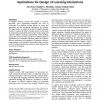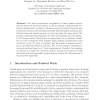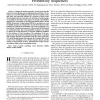52 search results - page 4 / 11 » View-Invariant Representation and Learning of Human Action |
TEI
2010
ACM
14 years 3 months ago
2010
ACM
In tangible learning systems, the facility to promote physically active engagement highlights the need to understand how different designs impact on action and interaction, and th...
CVPR
2010
IEEE
14 years 5 months ago
2010
IEEE
A central problem in the analysis of motion capture (Mo-
Cap) data is how to decompose motion sequences into primitives.
Ideally, a description in terms of primitives should
fac...
MVA
2010
13 years 7 months ago
2010
This paper presents a novel learning method for human action detection in video sequences. The detecting problem is not limited in controlled settings like stationary background or...
ICCV
2005
IEEE
14 years 2 months ago
2005
IEEE
Our goal is automatic recognition of basic human actions, such as stand, sit and wave hands, to aid in natural communication between a human and a computer. Human actions are infer...
TIP
2008
13 years 8 months ago
2008
Changes in motion properties of trajectories provide useful cues for modeling and recognizing human activities. We associate an event with significant changes that are localized in...



